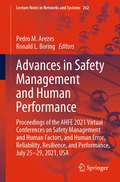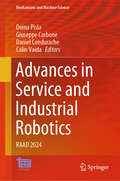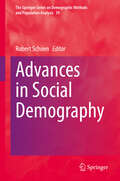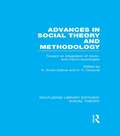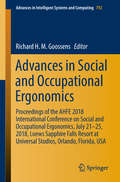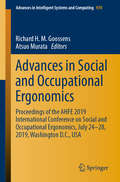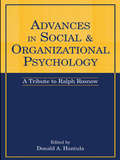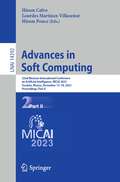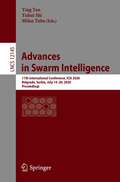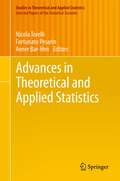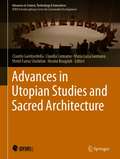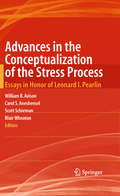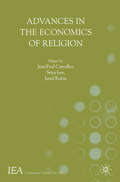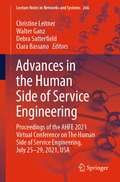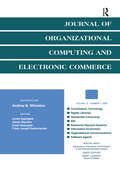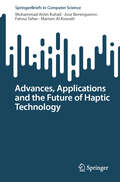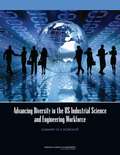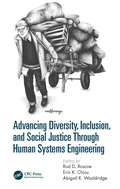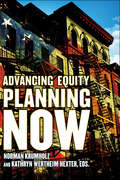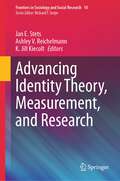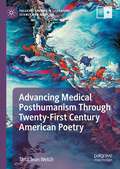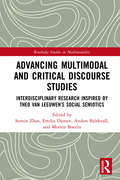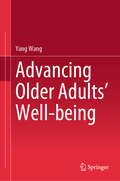- Table View
- List View
Advances in Safety Management and Human Performance: Proceedings of the AHFE 2021 Virtual Conferences on Safety Management and Human Factors, and Human Error, Reliability, Resilience, and Performance, July 25-29, 2021, USA (Lecture Notes in Networks and Systems #262)
by Ronald L. Boring Pedro M. ArezesThis book provides readers with a timely snapshot of research and developments relating to human reliability, performance and safety analysis, and human error, risk and safety management in various industrial contexts, such as manufacturing, transportation and health. It combines a diverse range of disciplines, including work physiology, health informatics, safety engineering, workplace design, injury prevention, and occupational psychology, and presents new strategies for safety management, accident prevention at the workplace, performance testing and participatory ergonomics. It discusses issues related to automation, and strategies for a safer Human-Automation Interaction. Based on the proceedings of the AHFE 2021 International Conferences on Safety Management and Human Factors, and Human Error, Reliability, Resilience, and Performance, which were held virtually on July 25-29, 2021, from USA, the book offers an extensive and inspiring guide for both researchers and practitioners dealing with the topics of safety management, human error prevention, and integration of automation in the workplace.
Advances in Service and Industrial Robotics: RAAD 2024 (Mechanisms and Machine Science #157)
by Giuseppe Carbone Doina Pisla Calin Vaida Daniel ConduracheThis book presents the Proceedings of the 33rd International Conference on Robotics in Alpe-Adria-Danube Region (RAAD), held in Cluj-Napoca, Romania, June 5–7, 2024. It gathers contributions by researchers from multiple countries on all major areas of robotic research, development, and innovation, as well as new applications and current trends. The topics include perception and learning, medical robotics and biomechanics, industrial robots and education, kinematics and dynamics, motion planning and control, service robotics and applications, mobile robots and innovative robot design, etc. Given its scope, the book offers a source of information and inspiration for researchers seeking to improve their work and gather new ideas for future developments.
Advances in Social Cognition, Volume I: A Dual Process Model of Impression Formation (Advances in Social Cognition Series)
by Jr. Robert S. Wyer Thomas K. SrullThis volume presents different perspectives on a dual model of impression formation -- a theory about how people form impressions about other people by combining information about a person with prior knowledge found in long-term memory. This information is of real importance to graduate students and advanced undergraduates in cognitive and social psychology, experimental psychology, social cognition and perception. Each volume in the series will contain a target article on a recent theoretical development pertinent to current study followed by critical commentaries offering varying theoretical viewpoints. This productive dialogue concludes with a reply by the target article author. The first volume of the series presents an evaluation of theoretical advances in social cognition and information processing from new and different perspectives. Volume 2 presents a new conceptualization of personality and social cognition by Cantor and Kihlstrom which addresses both new and old issues. The volumes in this series will interest and enlighten graduate and advanced undergraduates in cognitive and social psychology, experimental psychology, social cognition and perception. The first volume of the series presents an evaluation of theoretical advances in social cognition and information processing from new and different perspectives. Each volume in the series will contain a target article on a recent theoretical development pertinent to current study followed by critical commentaries offering varying theoretical viewpoints. This productive dialog concludes with a reply by the target article author. The information provided in Volume 1 promises to enrich graduate and advanced undergraduates in cognitive and social psychology, experimental psychology, social cognition and perception. This first volume of the series evaluates the theoretical advances made in social cognition and information processing from new and different perspectives. This unique and lively interchange between the target article author and the critics will enrich and enlighten psychologists from many disciplines. Each volume in the series will contain a target article on a recent theoretical development pertinent to current study followed by critical commentaries offering varying theoretical viewpoints. This productive dialog concludes with a reply by the target article author. The first volume of the series presents an evaluation of theoretical advances in social cognition and information processing from new and different perspectives. Volume 2 presents a new conceptualization of personality and social cognition by Cantor and Kihlstrom which addresses both new and old issues. All volumes in this series will interest and enlighten graduate and advanced undergraduates in cognitive and social psychology, experimental psychology, social cognition and perception.
Advances in Social Demography (The Springer Series on Demographic Methods and Population Analysis #59)
by Robert SchoenThis book offers an overview of the latest developments in contemporary population issues by examining the current unprecedented changes in fertility, family behavior, mortality, and migration. It explores new theoretical perspectives that seek to incorporate narratives of the future, demographic uncertainty, and determinants of unplanned pregnancy. The context of fertility is changing, and the new, important subjects of policy interventions, multi-partner fertility and complex parenthood are explored. Recent developments in assortative mating, partner choice, and relationship stability are examined in both national and international contexts, while further chapters analyze contemporary international migration. Methodological advances in modeling heterogeneity in mortality and extending period/cohort translation relationships are presented, and new analyses explore the implications of age patterns of fertility change. As such, this book provides up-to-date research spanning the entire field to illuminate contemporary developments, and will be of value to demographers, sociologists, economists, and all those interested in understanding demographic change.
Advances in Social Theory and Methodology: Toward an Integration of Micro- and Macro-Sociologies (Routledge Library Editions: Social Theory)
by Karin Knorr Cetina A. V. CicourelAfter a period in which sociology was torn apart by the polarized claims of micro- and macro-methodology, an increasing number of sociologists are now attempting a fusion of the two approaches. In this volume, some of the most distinguished sociologists set out possible resolutions of the debate. Each of the chapters, placed in perspective by the editors’ prologue, approaches the problem from a unique angle. Aaron Cicourel argues for a macro-basis of social interaction; Randall Collins shows how the macro consists of an aggregate of micro-episodes; Troy Duster presents a methodological model for generating a systematic data base across different contexts of social action through his examination of the procedures governing screening for inherited disorders. Rom Harré launches a philosophical attack on what he sees as a spurious bifurcation of micro- and macro-levels. Anthony Giddens explores the problem of unintended consequences, and Gilles Fauconnier, through a depiction of Jesuitical casuistry, shows how vital clues to macro-structure can be elicited from the micro-phenomenon of language. Victor Lidz continues the language theme in his chapter on the implications of advances in linguistic theory for macro-systems theory. Niklas Luhmann illustrates the micro-macro problem by the communication about law in interaction systems. The theory of historical materialism is reassessed by Jürgen Habermas. Taking the example of Renault and electric vehicles, Michel Callon and Bruno Latour investigate how micro-actor status is attained and the sociologist’s involvement in this transformation. Finally, Pierre Bourdieu, writing on men and machines, analyses the historical imperatives that create the complex relation between man and his environment.
Advances in Social and Occupational Ergonomics: Proceedings of the AHFE 2018 International Conference on Social and Occupational Ergonomics, July 21-25, 2018, Loews Sapphire Falls Resort at Universal Studios, Orlando, Florida, USA (Advances in Intelligent Systems and Computing #792)
by Richard H. GoossensThis book reports on cutting-edge research on social and occupational ergonomics, presenting innovative contributions to the optimization of sociotechnical management systems related to organizational, policy, and logistical issues. It discusses timely topics related to communication, crew resource management, work design, participatory design, as well as teamwork, community ergonomics, cooperative work, and warning systems, and explores new work paradigms, organizational cultures, virtual organizations, telework, and quality management. The book also describes pioneering infrastructures implemented for different purposes such as urban, health, and enterprise, and examines the changing role of automated systems, offering innovative solutions that address the needs of particular populations. Based on the AHFE 2018 International Conference on Social and Occupational Ergonomics, held in Orlando, Florida, USA on July 21–25, 2018, the book provides readers with a comprehensive overview of the current challenges in both organizational and occupational ergonomics, highlighting key connections between them and underlining the importance of emotional factors in influencing human performance.
Advances in Social and Occupational Ergonomics: Proceedings of the AHFE 2019 International Conference on Social and Occupational Ergonomics, July 24-28, 2019, Washington D.C., USA (Advances in Intelligent Systems and Computing #970)
by Richard H.M. Goossens Atsuo MurataThis book reports on cutting-edge research on social and occupational ergonomics, presenting innovative contributions to the optimization of sociotechnical management systems related to organizational, policy, and logistical issues. It discusses timely topics related to communication, crew resource management, work design, participatory design, as well as teamwork, community ergonomics, cooperative work, and warning systems, and explores new work paradigms, organizational cultures, virtual organizations, telework, and quality management. The book also describes pioneering infrastructures implemented for different purposes such as urban, health, and enterprise, and examines the changing role of automated systems, offering innovative solutions that address the needs of particular populations. Based on the AHFE 2019 International Conference on Social and Occupational Ergonomics, held on July 24-28, 2019, Washington D.C, USA, the book provides readers with a comprehensive overview of the current challenges in both organizational and occupational ergonomics, highlighting key connections between them and underlining the importance of emotional factors in influencing human performance.
Advances in Social and Organizational Psychology: A Tribute to Ralph Rosnow
by Donald A. HantulaThis new volume is a collection of thought-provoking essays on the current state of social and organizational psychology. The topics range from data analysis and interpretation, to research ethics, to theoretical issues, to an examination of psychological epistemology and theory. The book is divided into three sections. The first section, focuses on Ralph Rosnow’s greatest contribution to psychology, advancing our knowledge of the methods and ethics of research. This section introduces refinements in research methodology, ethical issues in the conduct of psychological research, and the thorny problems of artifact in behavioral research. Four of the chapters in the next section cover topics in organizational psychology (consumer behavior, rumor in organizational contexts, decision making, and leadership) and three review social psychological topics (science and social issues, smiling, and human values). The final section is a collection of chapters on theory from three eminent scholars. This thought provoking finale raises epistemological questions for future generations to solve.The book is intended for graduate students and scholars in social, organizational, and consumer psychology, and related disciplines such as communication, management, marketing, management information systems, and sociology.
Advances in Soft Computing: 22nd Mexican International Conference on Artificial Intelligence, MICAI 2023, Yucatán, Mexico, November 13–18, 2023, Proceedings, Part II (Lecture Notes in Computer Science #14392)
by Hiram Calvo Lourdes Martínez-Villaseñor Hiram PonceThe two-volume set LNAI 14391 and 14392 constitutes the proceedings of the 22nd Mexican International Conference on Artificial Intelligence, MICAI 2023, held in Yucatán, Mexico, in November 2023.The total of 49 papers presented in these two volumes was carefully reviewed and selected from 115 submissions.The proceedings of MICAI 2023 are published in two volumes. The first volume, Advances in Computational Intelligence, contains 24 papers structured into three sections:– Machine Learning– Computer Vision and Image Processing– Intelligent SystemsThe second volume, Advances in Soft Computing, contains 25 papers structured into three sections:– Natural Language Processing– Bioinformatics and Medical Applications– Robotics and Applications
Advances in Swarm Intelligence: 11th International Conference, ICSI 2020, Belgrade, Serbia, July 14–20, 2020, Proceedings (Lecture Notes in Computer Science #12145)
by Ying Tan Yuhui Shi Milan TubaThis book constitutes the proceedings of the 11th International Conference on Advances in Swarm Intelligence, ICSI 2020, held in July 2020 in Belgrade, Serbia. Due to the COVID-19 pandemic the conference was held virtually. The 63 papers included in this volume were carefully reviewed and selected from 127 submissions. The papers are organized in 12 cohesive topical sections as follows: Swarm intelligence and nature-inspired computing; swarm-based computing algorithms for optimization; particle swarm optimization; ant colony optimization; brain storm optimization algorithm; bacterial foraging optimization; genetic algorithm and evolutionary computation; multi-objective optimization; machine learning; data mining; multi-agent system and robotic swarm, and other applications.
Advances in Theoretical and Applied Statistics (Studies in Theoretical and Applied Statistics)
by Fortunato Pesarin Avner Bar-Hen Nicola TorelliThis volume includes contributions selected after a double blind review process and presented as a preliminary version at the 45th Meeting of the Italian Statistical Society. The papers provide significant and innovative original contributions and cover a broad range of topics including: statistical theory; methods for time series and spatial data; statistical modeling and data analysis; survey methodology and official statistics; analysis of social, demographic and health data; and economic statistics and econometrics.
Advances in Utopian Studies and Sacred Architecture (Advances in Science, Technology & Innovation)
by Hocine Bougdah Claudio Gambardella Claudia Cennamo Maria Luisa Germanà Mohd Fairuz ShahidanAt a time dominated by the disappearance of Future, as claimed by the French anthropologist Marc Augé, Utopia and Religion seem to be two different ways of giving back an inner horizon to mankind. Therefore this book, on the one hand, considers the importance of utopia as a tool and how it offers an economic and social resource to improve cities’ wealth, future and livability. On the other, it explores the impact of religious and cultural ideals on cities that have recently emerged in this context. Based on numerous observations, the book examines the intellectual legacy of utopian theory and practices across various academic disciplines. It also presents discussions, theories, and case studies addressing a range of issues and topics related to utopia.
Advances in Visual Informatics: 6th International Visual Informatics Conference, IVIC 2019, Bangi, Malaysia, November 19–21, 2019, Proceedings (Lecture Notes in Computer Science #11870)
by Timothy K. Shih Halimah Badioze Zaman Alan F. Smeaton Sergio Velastin Nazlena Mohamad Ali Tada Terutoshi Mohammad Nazir AhmadThis book constitutes the refereed proceedings of the 6th International Conference on Advances in Visual Informatics, IVIC 2019, held in Bangi, Malaysia, in November 2019.The 65 papers presented were carefully reviewed and selected from 130 submissions. The papers are organized into the following topics: Visualization and Digital Innovation for Society 5.0; Engineering and Digital Innovation for Society 5.0; Cyber Security and Digital Innovation for Society 5.0; and Social Informatics and Application for Society 5.0.
Advances in the Conceptualization of the Stress Process: Essays in Honor of Leonard I. Pearlin
by William R. Avison Scott Schieman Blair Wheaton Carol S. AneshenselThe stress process paradigm has been one of the most dominant conceptual models of health and illness over the past three decades. The contributions to this volume chart a new course for the stress process, extending the paradigm conceptually, methodologically, and substantively. Written in honor of Leonard I. Pearlin, the leading proponent of the stress process, the contributions to this volume provide a new direction for stress process research. Featuring contributions from leading researchers, and an afterword by Leonard I. Pearlin, this comprehensive volume covers three major sections: -Conceptual and methodological extensions of the stress process -The roles of family and work in the stress process, throughout the life course - Psychosocial factors that impact health outcomes. This volume will be an invaluable resource for researchers in sociology, social psychology and public health, all seeking to understand the pervasive role of stress on social disparities in health and illness.
Advances in the Economics of Religion (International Economic Association Series)
by Jared Rubin Sriya Iyer Jean-Paul CarvalhoThis edited collection brings together expertise from around the globe to overview and debate key concepts and concerns in the economics of religion. While the economics of religion is a relatively new field of research in economics, economists have made and continue to make important contributions to the understanding of religion. There is much scope for economists to continue to make a significant contribution to debates about religion, including its implications for conflict, political economy, public goods, demography, education, finance, trade and economic growth.
Advances in the Human Side of Service Engineering: Proceedings of the AHFE 2021 Virtual Conference on The Human Side of Service Engineering, July 25-29, 2021, USA (Lecture Notes in Networks and Systems #266)
by Walter Ganz Clara Bassano Christine Leitner Debra SatterfieldThis book reports on cutting-edge research and best practices in developing innovative service systems. It covers issues concerning the suitability of a given system for human use, human services, and excellent human experiences. It explores a wide range of ways in which human factors in engineering, ergonomics, human–computer interaction (HCI), cognitive engineering, and many other disciplines can contribute to the design and management of service systems. It considers aspects related to cost effectiveness, ethics, and privacy, among others, and covers applications in many areas, from healthcare to education, transportation, and the economy. Based on the AHFE 2021 Conference on the Human Side of Service Engineering, held virtually on 25–29 July, 2021, from USA, this book provides readers with a comprehensive overview of current research and future challenges in the field of service engineering, together with practical insights into the development of innovative services for various kinds of organizations.
Advances on information Technologies in the Financial Services industry: A Special Issue of the journal of Organizational Computing and Electronic Commerce
by Bruce W. Weber Robert J. KauffmanThe financial services industry is changing under the stimulus of advances in information technology (IT), telecommunications, and the Internet. Technological innovations and growing customer demand and sophistication have led to the emergence of new electronic financial markets, organizational forms for financial services firms, products, and product delivery capabilities. This special issue highlights Information Systems (IS) research on management topics in the financial services that involve IT. The authors utilize a mix of research methodologies to examine a range of innovative applications of IT in the financial services industry.
Advances, Applications and the Future of Haptic Technology (SpringerBriefs in Computer Science)
by Mohammad Amin Kuhail Jose Berengueres Fatma Taher Mariam Al KuwaitiAre you a technologist or innovator looking to stay ahead in the rapidly evolving world of haptic technology? "Advances, Applications and the Future of Haptic Technology" is your essential guide to understanding and predicting trends that can shape how you use haptics in your products and strategies. This book begins by defining haptic technology and its classifications. It then traces the evolution of haptic feedback systems and explores their historical significance. Through real-world case studies, the book demonstrates how haptic feedback is reshaping industries like healthcare and gaming, enhancing medical training, and creating immersive gaming experiences. For innovators, the book addresses the challenges of implementing haptic technology across various domains, highlighting technical complexities and ergonomic considerations. For technologists, this book provides insights into the trade-offs of adopting haptics, examining the evolution of these systems with a focus on personal communication devices and the automotive industry. It also analyzes the factors influencing impact and features foresight frameworks to provide you with strategies for the future of haptic innovation. Additionally, the book explores intellectual property trends in the health, gaming, and automotive sectors to highlight key haptic innovations. Get your copy today and harness haptic technology to shape your future!
Advancing Diversity in the US Industrial Science and Engineering Workforce: Summary of a Workshop
by Rita S. GuentherThousands of gifted individuals, including women and underrepresented minorities, remain a disproportionally small fraction of those in science, technology, engineering, and math (STEM) careers. Industry, as the largest employer category of those with STEM backgrounds, stands to benefit considerably from greater inclusion of women and underrepresented minorities in the workforce. However, nothing short of a game-changing environment must be created to harness the talent of those not fully represented in the STEM workforce. Advancing Diversity in the US Industrial Science and Engineering Workforce is the summary of a workshop held in May, 2012 by the National Academy of Engineering, focusing on the needs and challenges facing industry in particular, and it is intended to facilitate further discussion and actions to address these complex issues. The workshop provided a forum for leaders from industry, academia, and professional associations to share best practices and innovative approaches to recruiting, retaining, and advancing women and underrepresented minorities in the scientific and engineering workforce throughout the nation's industries.
Advancing Diversity, Inclusion, and Social Justice Through Human Systems Engineering
by Rod D. Roscoe Erin K. Chiou Abigail R. WooldridgeWinner of the "Outstanding Academic Title" recognition by Choice for the 2020 OAT Awards. The Choice OAT Award represents the highest caliber of scholarly titles that have been reviewed by Choice and conveys the extraordinary recognition of the academic community.Advancing Diversity, Inclusion, and Social Justice through Human Systems Engineering highlights how scholars and practitioners of HSE (inclusively defined to span many fields) can apply their theories and methods to understand and support healthy communities, include and empower diverse populations, and inspire strategies for a more inclusive future. This volume brings together experts from human factors, ergonomics, psychology, human-computer interaction, and more to demonstrate how these fields can be applied to societal challenges and solutions. Through a blend of research reports, literature reviews, and personal narratives, this volume explores these issues from the individual to the global scale, across diverse populations, and across multiple continents. Features Draws upon human factors and ergonomics theories and methods to evaluate, understand, and confront systemic threats to inclusion and social justice Offers actionable methodologies, strategies, and recommendations for conducting human-centered research, design, and training with marginalized or vulnerable populations Offers a venue for reporting and reconsidering the work of human factors and ergonomics from the perspectives of diversity, inclusion, and social justice
Advancing Equity Planning Now
by Edited by Norman Krumholz and Kathryn Wertheim HexterWhat can planners do to restore equity to their craft? Drawing upon the perspectives of a diverse group of planning experts, Advancing Equity Planning Now places the concepts of fairness and equal access squarely in the center of planning research and practice. Editors Norman Krumholz and Kathryn Wertheim Hexter provide essential resources for city leaders and planners, as well as for students and others, interested in shaping the built environment for a more just world.Advancing Equity Planning Now remind us that equity has always been an integral consideration in the planning profession. The historic roots of that ethical commitment go back more than a century. Yet a trend of growing inequality in America, as well as other recent socio-economic changes that divide the wealthiest from the middle and working classes, challenge the notion that a rising economic tide lifts all boats. When planning becomes mere place-making for elites, urban and regional planners need to return to the fundamentals of their profession. Although they have not always done so, planners are well-positioned to advocate for greater equity in public policies that address the multiple objectives of urban planning including housing, transportation, economic development, and the removal of noxious land uses in neighborhoods.Thanks to generous funding from Cleveland State University, the ebook editions of this book are available as Open Access volumes from Cornell Open (cornellopen.org) and other repositories.
Advancing Identity Theory, Measurement, and Research (Frontiers in Sociology and Social Research #10)
by Jan E. Stets Ashley V. Reichelmann K. Jill KiecoltThis volume presents recent advances in identity theory, which is a prominent and active theory in sociological social psychology and a versatile framework for explaining the sources of identities, how they develop, how they operate in situations and groups, and how they influence behavior and well-being. The volume is organized around new theoretical developments, measurement techniques, and research in the field. Theoretical developments covered in the volume sharpen, reframe, and expand fundamental concepts in identity theory. State-of-the-art techniques for measuring identities assess, refine, and update existing measures. New research in the volume addresses both individual processes and outcomes and group processes and outcomes. The chapters together showcase the wide applicability of identity theory to a host of identities, such as the religious, gender, sexual, physical attractiveness, racial/ethnic, parent, student, partisan, and group member identities. The volume editors introduce identity theory and provide an overview of the chapters. In the last chapter, they describe how this volume points to future directions for advancing theory, measurement, and research in identity theory. This volume is of interest to a wider readership, including sociological social psychologists, sociologists, and scholars in other disciplines (psychology, political science, economics, education) whose research or teaching deals with identities. Graduate and advanced undergraduate students interested in identity research will also find this book accessible. Finally, this is for discerning laypersons who are interested in how identities influence and shape their lives and affect their well-being.
Advancing Medical Posthumanism Through Twenty-First Century American Poetry (Palgrave Studies in Literature, Science and Medicine)
by Tana Jean WelchAdvancing Medical Posthumanism Through Twenty-First Century American Poetry places contemporary poetics in dialogue with posthumanism and biomedicine in order to create a framework for advancing a posthuman-affirmative ethics within the culture of medical practice. This book makes a case for a posthumanist understanding of the body—one that sees health and illness not as properties possessed by individual bodies, but as processes that connect bodies to their social and natural environment, shaping their capacity to act, think, and feel. Tana Jean Welch demonstrates how contemporary American poetry is specifically poised to develop a pathway toward a posthuman intervention in biomedicine, the field of medical humanities, medical discourse, and the value systems that guide U.S. healthcare in general.
Advancing Multimodal and Critical Discourse Studies: Interdisciplinary Research Inspired by Theo Van Leeuwen’s Social Semiotics (Routledge Studies in Multimodality)
by Sumin Zhao Emilia Djonov Anders Björkvall Morten BoeriisAs a founder and leading figure in multimodality and social semiotics, Theo van Leuween has made significant contributions to a variety of research fields, including discourse analysis, sociolinguistics, communication and media studies, education, and design. In celebration of his illustrious research career, this volume brings together a group of leading and emerging scholars in these fields to review, explore and advance two central research agendas set out by van Leeuwen: the categorisation of the meaning potential of various semiotic resources and the examination of their uses in different forms of communication, and the critical analysis of the interaction between semiotic forms, norms and technology in discursive practices. Through 11 cutting-edge research papers and an experimental visual essay, the book investigates a broad range of semiotic resources including touch, sound, image, texture, and discursive practices such as community currency, fitness regime, film scoring, and commodity upcycling. The book showcases how social semiotics and multimodality can provide insights into the burning issues of the day, such as global neoliberalism, terrorism, consumerism, and immigration.
Advancing Older Adults' Well-being
by Yang WangThis book introduces part of the advances of the aging research conducted by Dr. Yang Wang and his collaborators since 2022. It covers several topics related to older adults, including their psychological and social well-being, their role as caregivers and care receivers, the impact of the maltreatment experience in early life, and how witnessing elder abuse could influence children. This book is composed of nine research articles and manuscripts. Most of the studies were conducted in China or USA, using nationally representative sample. This book is a valuable resource for readers who care about older adults’ well-being and the advancement of it.
